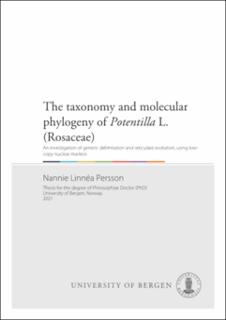The taxonomy and molecular phylogeny of Potentilla L. (Rosaceae) : An investigation of generic delimitation and reticulate evolution, using low-copy nuclear markers
Doctoral thesis
Permanent lenke
https://hdl.handle.net/11250/2724172Utgivelsesdato
2021-01-15Metadata
Vis full innførselSamlinger
Sammendrag
The process of polyploidization (genome duplication) is a common mechanism in plant speciation. Autopolyploidy arises within one species, and allopolyploidy arises after hybridization. Ploidy levels in the genus Potentilla in the rose family (Rosaceae) range from 2x to 16x, but taxonomists have disagreed on which species should be included in the genus. In previous phylogenetic analyses, a few major subclades were identified and informally named Alba, Anserina, Argentea, Fragarioides, Ivesioid and Reptans, but their relationships to one another differed depending on what type of DNA (chloroplast or nuclear ribosomal) was studied. In addition, some species were found in different subclades in the trees. The fact that chloroplast or nuclear ribosomal DNA may be uniparentally inherited and that most of the species are polyploid led to an interpretation of an evolutionary history that involves hybridization and polyploidization in Potentilla. Better suited for the study of polyploids are low-copy nuclear (LCN) DNA markers, which are present in each subgenome and inherited from both the maternal and the paternal parent. LCN markers were in this thesis used for three different purposes in Potentilla: 1), to infer the relationships of the major subclades in the genus (Paper I); 2), to trace the putative hybrid origins of a number of North American polyploid species in the ‘Rivales group’ (Papers II and III); and 3), to assess the generic delimitation of Potentilla (Paper IV).
A fully resolved and supported tree showing the major subclades in Potentilla was obtained after excluding the Fragarioides species. Two of the clades, the Ivesioid and Reptans clades, showed signs of being of autopolyploid origin. In contrast, five of the six species in the Rivales group occurring in North America were inferred to be allopolyploids with ancestral lineages in the Argentea and Ivesioid clades. Four lines of evidence (ploidy level, distribution of extant species, relationships seen in the gene trees, and a set of network analyses) indicated that precursors to three of the Rivales species have taken part in hybridizations that eventually formed a common ancestor for the high-ploidy Rivales species P. intermedia and P. norvegica. Parts of this population dispersed to Eurasia, while the rest remained in North America. Both lineages went through at least one more hybridization each and formed P. intermedia in Eurasia and P. norvegica in North America. Since many floras state that P. norvegica is of European origin, this will have implications for its assessment as native or introduced on both continents. The gene trees inferred in Papers I, II and III showed a network of gene flow between the Alba, Argentea, Fragarioides, Ivesioid and Reptans clades. Thus, the generic delimitation of Potentilla was set to include these clades, and excluding the Anserina clade. With this delimitation only six species, out of the ca 400 in the whole genus, had to be recombined to get new Potentilla names.
The LCN markers revealed relationships that could not have been found by chloroplast or nuclear ribosomal markers. This points to the importance of continuing using LCN markers when investigating the evolutionary history of polyploids. Additional markers are, however, needed to resolve some relationships, especially the putatively diploid Fragarioides species destabilizing the backbone phylogeny, and some species in the Rivales group of which we could not find all putative ancestral lineages. The High-Throughput Sequencing technique Target Capture could potentially generate enough data to solve these problems. Software programs that analyze reticulate evolution still struggle with species of high ploidy levels, and a good deal of manual preparation of analyses and interpretation of the results are still needed. In addition, a discussion is needed concerning criteria for species delimitation of allopolyploids. If the ancestral lineages are distantly related, this could have implications at even higher taxonomical levels, such as genera and families.
Består av
Paper I: Persson NL, Toresen I, Andersen HL, Smedmark JEE, Eriksson T. 2020. Detecting destabilizing species in the phylogenetic backbone of Potentilla L. (Rosaceae) using low-copy nuclear markers. Annals of Botany Plants 12(3):plaa017. The article is available at: https://hdl.handle.net/11250/2724165Paper II: Persson NL, Eriksson T, Smedmark JEE. 2020. Complex patterns of reticulate evolution in opportunistic weeds (Potentilla L., Rosaceae), as revealed by lowcopy nuclear markers. BMC Evolutionary Biology 20:38. The article is available at: https://hdl.handle.net/11250/2724168
Paper III: Persson NL, Eriksson T, Smedmark JEE. Native or introduced? Tracing the origins of high-level allopolyploids in North America (Potentilla L., Rosaceae). The article is not available in BORA.
Paper IV: Eriksson T, Persson NL, Smedmark JEE. What is Potentilla? A phylogeny-based taxonomy for Potentillinae (Rosaceae). The article is not available in BORA.
